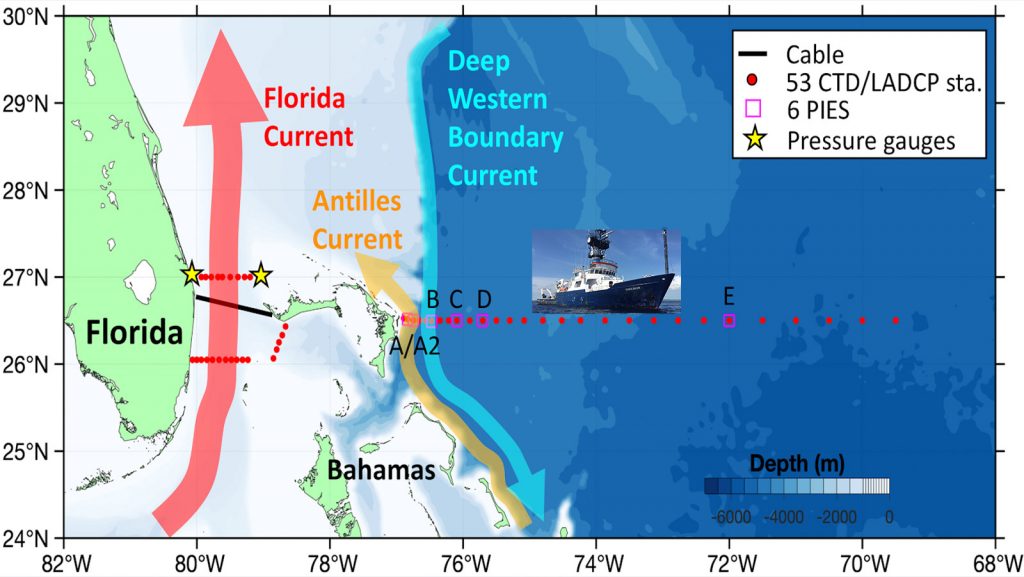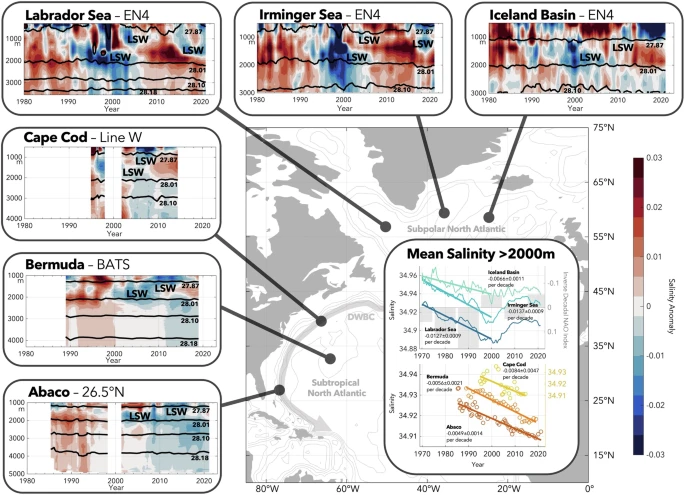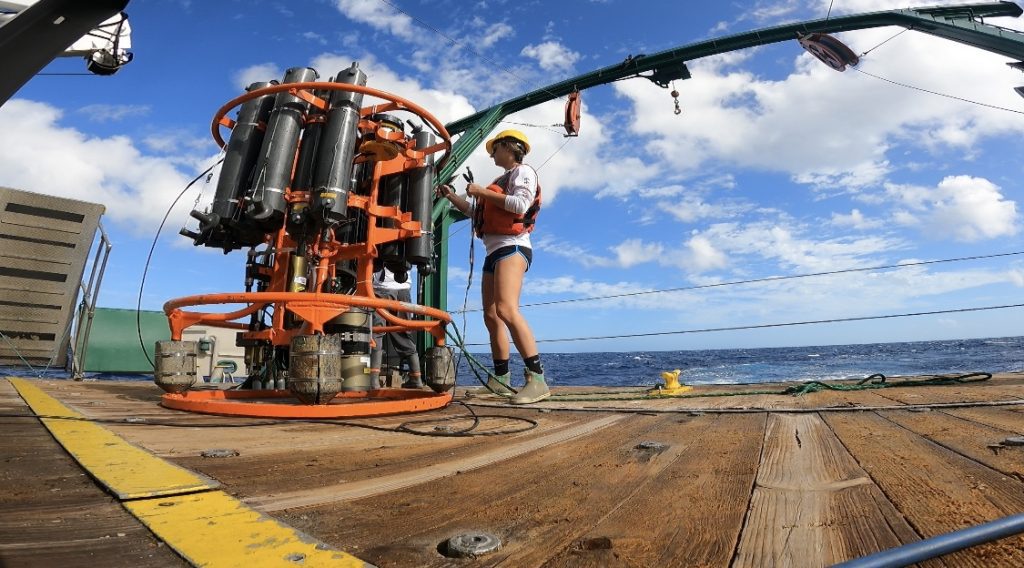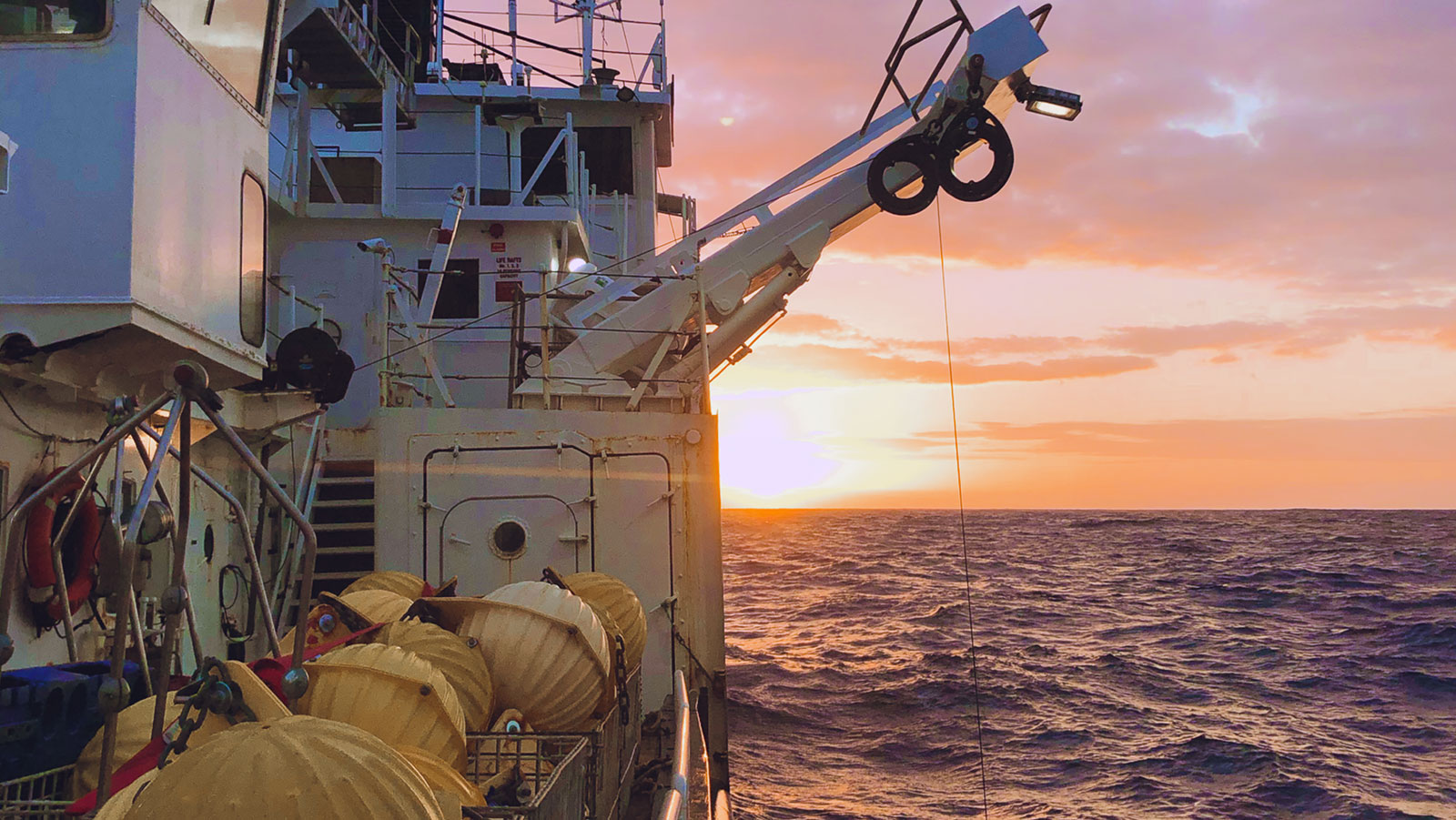New study reveals long-term cooling and freshening of the deep Subtropical North Atlantic Ocean, with hints of major shifts to come over next decade
A new study published in Nature Communications, Earth & Environment unveils a surprising new take on the matter of ocean warming. Scientists with the University of Miami Cooperative Institute for Marine and Atmospheric Studies (CIMAS) and Rosenstiel School, and NOAA AOML analyzed nearly four decades of ocean observations along the Abaco 26.5°N hydrographic line and found evidence of significant cooling and freshening of the deep ocean at 26.5°N. However, this cooling and freshening is not expected to continue. The study also found a climatic link between the deep Subtropics and Subpolar North Atlantic, indicating that warming of the deep ocean is expected in the future.
One of the consequences of human-induced warming of the global atmosphere is ocean heat uptake. The amount of heat that enters into the atmosphere is greater than what escapes back out into space. Most of this excess atmospheric heat is absorbed by the ocean. As a result, ocean heat content has increased significantly over the past few decades. As the concentration of greenhouse gases in Earth’s atmosphere continues to increase, so does the amount of heat that is stored in the ocean. The ocean is storing an estimated 91% of the excess heat energy trapped in the Earth’s climate system.
Warmer ocean waters are connected to changes in day-to-day weather, increased sea level rise, changes in migration patterns of different fish and mammals, stronger storm events, like hurricanes, and influence longer-term climate events such as El Niño and La Niña. Therefore, it is important for scientists to have an understanding of how much and how fast the ocean is warming and what the impacts will be.
The Abaco 26.5°N hydrographic line off Abaco Island, Bahamas is part of an international partnership between the NOAA AOML Western Boundary Time Series (WBTS) program, the University of Miami Meridional Overturning Circulation and HeatFlux Array (MOCHA) project, and the UK RAPID program. Nearly four decades of sustained observations along this latitude make this hydrographic line part of the longest-running trans basin meridional overturning observation program on the planet. Early NOAA AOML contributions to this project began in 1985, and the full international collaboration reached a 20 year milestone in 2024.

The hydrographic line consists of routinely sampled hydrographic stations, tall-moorings, and bottom-mounted Pressure Inverted Echo Sounder (PIES) instruments, which collectively survey the water mass properties and speed of the currents in this region, especially those of the deep ocean. Understanding the variability and propagation of these deep ocean water masses over long time scales allow researchers to better understand the variability, pathways, and timescales of the basin-wide Atlantic Meridional Overturning Circulation (AMOC).
“While a majority of the deep Atlantic ocean has been warming, we find here through our observing systems that this region of the Atlantic along the eastern coast of the US and Bahamas has instead become significantly colder and fresher over time. The deep ocean water masses that are sampled at the 26.5°N Hydrographic line are nestled within the deep currents that drive the AMOC, pumping water from the Subpolar to Subtropical Atlantic. The property shifts we observe at this latitude within these deep water masses allow us to understand how these deep currents are changing and give us insight as to where they came from. We use these properties, like anomalously cold or fresh deep water, as unique fingerprints to trace how these currents move and how fast the overturning occurs,” said Leah Chomiak, lead author of the study and a University of Miami CIMAS scientist.


AMOC is the Atlantic Ocean portion of the Global Meridional Overturning Circulation, a large-scale ocean circulation system that carries heat, salt, carbon, and other biogeochemical elements along its paths. Changes in its strength can cause basin-wide impacts in ocean warming, as well as weather, sea level, extreme weather events, and ecosystem imbalance. Therefore, continued observation and monitoring over the next few decades is critical for addressing forthcoming climate, ecosystem, and societal impacts.
The study also suggests a climatic link between the deep Subpolar North Atlantic and the Subtropics. Given the similarities between this observed freshening at 26.5°N and a multi-decadal freshening event in the subpolar Atlantic that occurred more than two decades ago, it is suggested that it takes around 20 years for waters in the deep subpolar Atlantic to reach the subtropics.
The Subpolar North Atlantic is the region of the North Atlantic Ocean situated roughly between 45°N and 65°N (near Iceland, Greenland, Norway, Canada). The Subtropics are the regions immediately to the north and south of the tropics, from ~23.4° to approximately 35° to 40° north and south (near the southeastern United States, Bahamas, Brazil, Argentina).
The observations and connectivity between these two regions is a major finding because the ocean acts as the memory for the Earth’s climate system and can be an early warning system for what is to come. Because the AMOC plays a huge role in modulating weather, climate, and sea level, understanding how long it takes for water masses to move through the AMOC allows scientists to better predict changes in the future.

“Looking at observing systems in the Subpolar North Atlantic and comparing trends, we find that the deep waters we observe now at 26.5°N are the same deep waters that were formed in the Subpolar North Atlantic more than 20 years prior. The link identified between these two regions suggests that changes to deep water formation in the Subpolar region are reflected in the Subtropics over two decades later, carried by the currents of the AMOC system. This link, based now on the observed cooling and freshening patterns of the deep ocean water masses, is critical to understand what is ‘coming down the pipeline’ in a literal sense through the Atlantic overturning process,” said Chomiak.
Despite the decades-long cooling and freshening trend in the Subpolar North Atlantic, observations within the past few decades in the region have shown a significant increase in temperature and salinity. This same shift to deep ocean warming is anticipated to reach the Subtropics in the near future, which has the potential to accelerate sea level rise along the Atlantic Coast, among other societal issues.
This deep ocean warming and salinification could have notable impacts on Atlantic deep ocean heat content, circulation, and sea level changes. This study emphasizes the importance of continuing to collect direct observations to better understand ocean changes.
